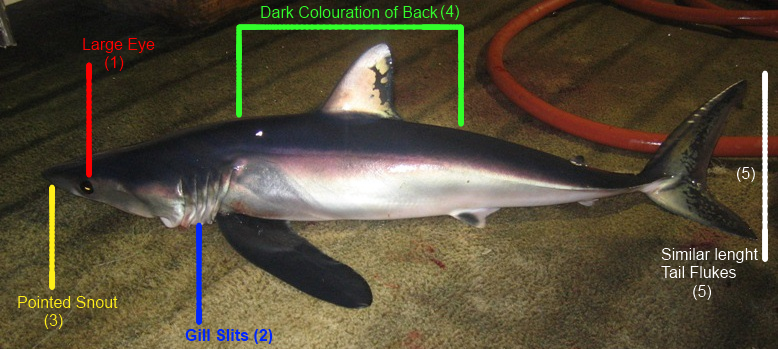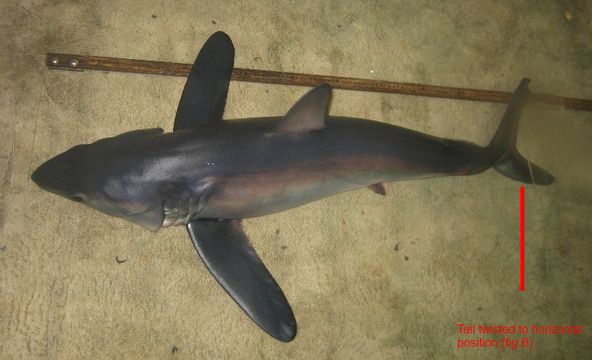here is a first draft, so apologies if its a little disorganised:
I think the best way is to use the original text and add my thoughts.
Key:
Black = original text
Red = Original text I feel is important.
Blue = My comments
A New Shark I believe it was a male Longfin Mako Shark (Isurus paucus)
Shark like a Porpoise
caught off ST. Andrews.
Sharks are so common in the neighbouring oceans and are so
frequently hooked by fishermen when they would rather be hooking
something else that the capturing of a shark is only worth mentioning
in print when the circumstances or the species is uncommon.
The matter was the case with the shark caught yesterday afternoon
about 14 miles S.E. from Timaru Bay. messers Oddie and McCormac,
who where fishing for grouper in the oil launch .....
When I retyped the original faded text, i read this part as "Grouper" after some further research I realised that there is a fish called a "Groper" indigenous to the sea off Timaru bay. A groper or Hapuku (Polyprion oxygeneios) is a Wreckfish living in a depth range of 50-854 meters
here is a quote taken from a report from the same newspaper, describing fishing for "groper" in the 1900s: "we arrived at the fishing grounds and let down, the grapnel. The tackle used for fishing were stout hand lines with two or three big hooks i attached and a heavy sinker. Each fisherman attended to two lines"*
Here is a Picture of an "Oil Launch" (Boat) in New Zealand (1910)
Now on to the description of the unexpected catch:
The shark made a tough fight and the two men had to spend a couple
of hours over it before getting it into the boat, and it was squirming
for a long time after that. The capture appeared to be worth the
trouble, as it was quite a novelty to them,
being as much like a porpoise as a shark. its form and colour generally resemble those of a porpoise. and more remarkable still its tail is fluked horizontally instead
of the vertically: and the flukes are nearly of equal length. this and
the whole shape of the body. which is comparatively short and torpedo head,
suggest that this shark has been constructed so that it might pretend
to be a porpoise. Any fisherman glancing at it from a little distance
would declare it to be a porpoise.
I think this is the thing that made me suspect this was just a porpoise that had been misidentified.
ALL Sharks tails move Vertically. including the Longfin Mako. However:
large eyes(1), gill slits(2) and shagreen skin,
however "give it away" as a shark on close examination. the body
tapers away gradually and gracefully from a back fin about 10 inches high,
to a sharp pointed snout(3). very different from the shovel-head of the
common local shark.
the teeth(fig C) are quite slender spines about half an inch
long and nearly as far appart, set in a double row. by no means a formidable
looking armourment.
the skin of the back is almost black(4) and silky sleek
when stroked the right way, and compared with other sharks skin,
is but faintly rough the other way. the body is just like that of a porpoise
in shape. the tail is perhaps the most remarkable thing about this fish, for
it is twisted from the perpendicular to the horizontal position(fig B).
the flukes are nearly of the same lenght(5) instead of one being very much longer
than the other, and they measure about 15 inches from tip to tip. the twist
shows plainly, as a low ridge along the back curves round shapley with one fluke;
a similar ridge does the same below; and a second ridge curving with each makes
a neat an conspicious groove on each side.


fig C:
Altogether it is a remarkable kind of
shark.
Its captors propose to exhibit to-day, probably on the north mole reclamation.
I wish some one had gone down to take a photograph!
In a nutshell I propose that whilst fishing for "groper" a Long fin Mako shark was caught
and correctly identified as a new species of shark (given that the species Isurus paucus was first identified in 1966) However for some reason the shark was never scientifically examined by a marine biologist. I suspect that the concept of the tail being horizontal rather than vertical lead to this report being "ignored" or maybe it was just a case of an opportunity missed.
Regarding the tail I am convinced that the "misdescription" was due to confusion rather than being intentionally dishonest. If we look at the second photograph we can see that the tail "appears" to be horizontal, but the tail in the first picture is in its "natural" position and is clearly vertical.
*
Papers Past — Timaru Herald — 1 May 1909 — ON THE GROPER GROUNDS.








